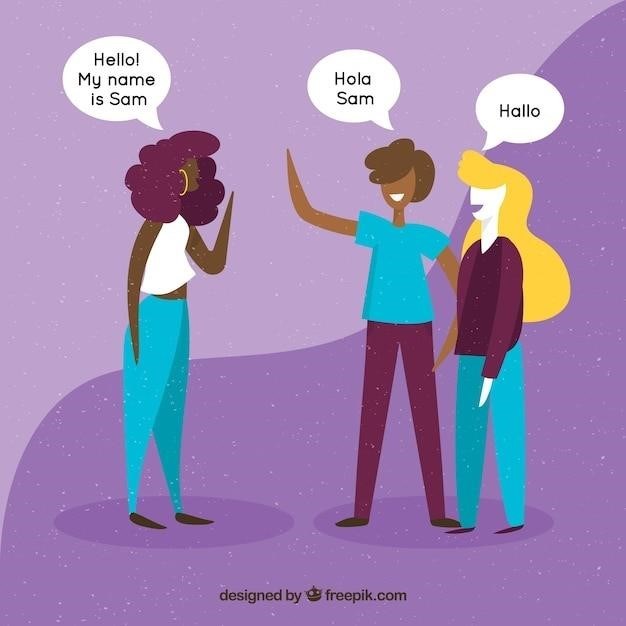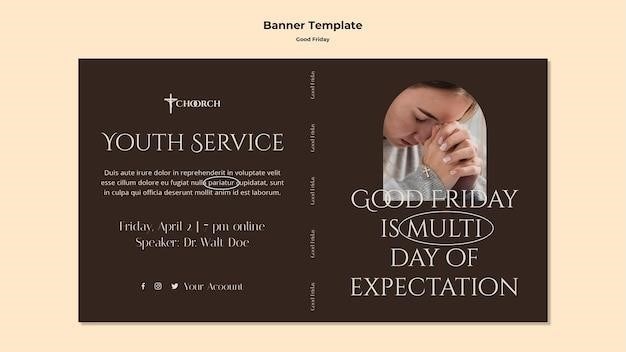
How to Greet Others in English⁚ A Comprehensive Guide for ESL Learners
This comprehensive guide will teach you all the essential English greetings you need to know as an ESL learner․ From formal to informal, time-based to occasion-specific, we’ll cover everything you need to confidently navigate social situations and make a positive impression․
Introduction
Greetings are the building blocks of any language․ They are the first words we use when we meet someone, and they set the tone for the conversation to follow․ In English, there are many different ways to greet others, and the appropriate greeting will depend on the context of the situation․ This guide is specifically designed for ESL learners, providing you with a clear understanding of how to use greetings effectively in various settings․
Whether you’re a beginner or have some experience with English, mastering greetings is essential for building confidence in your communication skills․ This comprehensive guide will equip you with the knowledge and practice you need to confidently greet others in English, making a positive impression in all your interactions․
We’ll explore different types of greetings, including formal and informal options, time-based greetings, and greetings for specific occasions․ You’ll also learn how to respond appropriately to greetings and how to introduce yourself in various contexts․ By the end of this guide, you’ll be well-equipped to confidently navigate social situations and communicate effectively in English․
The Importance of Greetings
Greetings are more than just a simple formality in any language․ They serve a crucial role in shaping first impressions, establishing connections, and setting the tone for interactions․ In the context of English as a Second Language (ESL), mastering greetings becomes even more significant, as it enables learners to navigate social situations confidently and build rapport with native speakers․
When you greet someone appropriately, you demonstrate respect, politeness, and a willingness to engage․ This can make a positive impression and create a more comfortable environment for communication․ Additionally, using appropriate greetings can help you avoid awkward silences or misunderstandings that might arise from cultural differences․
Imagine walking into a new classroom or meeting a colleague for the first time․ A simple “Hello” or “Good morning” can instantly break the ice, create a sense of warmth, and signal that you’re approachable and ready to interact․ Mastering greetings can be a powerful tool for ESL learners, opening doors to new friendships, professional opportunities, and a greater sense of belonging in English-speaking communities․
Formal Greetings
Formal greetings are typically used in professional settings, when addressing someone you don’t know well, or in situations where a more respectful tone is required․ These greetings are characterized by their politeness and formality, often accompanied by titles like “Mr․,” “Ms․,” “Mrs․,” or “Dr․”
Here are some common formal greetings in English⁚

- Good morning⁚ Used from sunrise to noon․
- Good afternoon⁚ Used from noon to sunset․
- Good evening⁚ Used from sunset to bedtime․
- Hello⁚ A versatile greeting suitable for all times of day․
- It’s a pleasure to meet you⁚ Used when meeting someone for the first time․
- How do you do?⁚ A formal greeting, often followed by “How do you do?” as a response․
- Nice to meet you⁚ A more casual but still polite greeting․
When using formal greetings, it’s important to maintain eye contact, smile, and speak clearly․ Additionally, it’s courteous to introduce yourself and inquire about the other person’s well-being․
Informal Greetings
Informal greetings are used in casual settings with friends, family, and acquaintances․ They are typically more relaxed and friendly, reflecting a closer relationship between the individuals․
Here are some common informal greetings in English⁚
- Hi⁚ A universal informal greeting suitable for most situations․
- Hey⁚ A more casual and friendly greeting, often used among close friends․
- Hello⁚ While considered formal in some contexts, “hello” can also be used informally․
- What’s up?⁚ A common informal greeting, often followed by “Not much, you?” or “Just chilling․”
- How are you doing?⁚ A friendly and informal way to inquire about someone’s well-being․
- Long time no see!⁚ Used when you haven’t seen someone in a while․
- Good to see you!⁚ A warm and friendly greeting, expressing your pleasure at seeing the other person․
When using informal greetings, it’s important to consider the context and your relationship with the other person․ Avoid using overly casual greetings in formal settings․ For example, using “Hey” when addressing a teacher or boss would be inappropriate․
Time-Based Greetings
Time-based greetings are a polite way to acknowledge the time of day and show respect for the other person․ They are commonly used in both formal and informal settings, but are particularly appropriate when meeting someone for the first time or in a professional setting․
Here are some common time-based greetings in English⁚
- Good morning⁚ Used from sunrise to noon, typically before 12⁚00 PM․
- Good afternoon⁚ Used from noon to sunset, typically between 12⁚00 PM and 6⁚00 PM;
- Good evening⁚ Used from sunset to bedtime, typically after 6⁚00 PM․
While “good morning” is the most widely used time-based greeting, “good afternoon” and “good evening” are less common․ You can also use a more casual version of “good morning” by simply saying “Morning” or “Afternoon” or “Evening․”
Remember that time-based greetings are a polite way to acknowledge the time of day, but they are not always necessary․ If you are greeting someone you know well, a simple “Hi” or “Hey” may be sufficient․
Greetings for Specific Occasions
Specific occasions often call for unique greetings that convey warmth, festivity, or sympathy․ These greetings can enhance your communication and show you’ve considered the occasion’s significance․
Here are some greetings for specific occasions⁚

- Happy Birthday⁚ A cheerful greeting for someone’s birthday․
- Merry Christmas⁚ A traditional greeting for Christmas․
- Happy New Year⁚ A greeting for the start of a new year․
- Happy Holidays⁚ A general greeting for the holiday season, especially during December․
- Happy Hanukkah⁚ A greeting for the Jewish festival of lights․
- Happy Easter⁚ A greeting for the Christian holiday of Easter․
- Happy Ramadan⁚ A greeting for the Muslim month of fasting․
- Happy Diwali⁚ A greeting for the Hindu festival of lights․
- Congratulations⁚ A greeting for a special achievement or event, like a graduation, promotion, or marriage․
- My condolences⁚ A heartfelt greeting to express sympathy for a loss․
These greetings are versatile and can be used in both formal and informal settings․ When unsure, a simple “Happy [occasion]” is always appropriate․
Using Greetings in Different Contexts
The way you greet someone can vary greatly depending on the context of the interaction․ Understanding the nuances of different situations will help you choose appropriate greetings and avoid any awkwardness․
Here are some examples of how greetings can change based on context⁚
- Formal Settings⁚ In professional environments, like business meetings or conferences, it’s best to stick to formal greetings like “Good morning” or “Good afternoon․” It’s also appropriate to use titles like “Mr․,” “Ms․,” or “Dr․” before someone’s name․
- Informal Settings⁚ When you’re with friends or family, more informal greetings like “Hey” or “Hi” are acceptable․ You can also use nicknames or terms of endearment․
- Online Interactions⁚ Online communication, such as emails or social media, often has its own set of greeting conventions․ “Hi” or “Hello” are common, while “Dear [Name]” is more formal․
- Phone Calls⁚ Starting a phone call with “Hello” is standard․ If you know the person well, you can use a more informal greeting․
By considering the context, you can choose the most appropriate greeting for the situation and create a positive impression․
Common Phrases for Introducing Yourself
Once you’ve mastered greetings, you’ll need to know how to introduce yourself․ This is a crucial step in building connections and starting conversations․ Here are some common phrases to use⁚
- “Hello, my name is [your name]․” This is a classic and straightforward way to introduce yourself․
- “Hi, I’m [your name]․” This is a more casual and friendly option;
- “Nice to meet you․” This is a polite and welcoming phrase to use after you’ve introduced yourself․
- “It’s a pleasure to meet you․” This is a more formal and gracious way to express that you’re happy to meet someone․
After introducing yourself, you can follow up with a question to keep the conversation going․ For example, you could ask⁚
- “What brings you here today?”
- “Have you been to this event before?”
- “What do you do for a living?”
Remember to smile and make eye contact when introducing yourself․ These nonverbal cues can make a big difference in creating a positive first impression․
Responding to Greetings
Responding to greetings is just as important as initiating them․ Here are some common responses to various greetings⁚
- To “Hello,” “Hi,” or “Hey”⁚ You can simply respond with “Hello,” “Hi,” or “Hey” back․ You can also add a friendly “How are you?” or “Good to see you․”
- To “Good morning,” “Good afternoon,” or “Good evening”⁚ Return the greeting by saying “Good morning,” “Good afternoon,” or “Good evening․” You can also add a brief comment, such as “It is a beautiful morning,” or “How’s your day going?”
- To “How are you?” or “How are you doing?”⁚ These are common ways to inquire about someone’s well-being․ The most common response is “I’m fine, thank you․ How are you?” You can also say “I’m doing well,” or “I’m okay․”
- To “Nice to meet you”⁚ Respond with “Nice to meet you too,” or “It’s a pleasure to meet you․”
- To “It’s good to see you again”⁚ Reply with “It’s good to see you again too,” or “It’s been a while!”
Remember to be polite and enthusiastic when responding to greetings․ It shows that you’re engaged in the conversation and interested in the other person․
Practice Activities
The best way to learn and master greetings is through practice․ Here are some fun and engaging activities you can do to improve your skills⁚
- Role-Playing⁚ Partner up with a friend or classmate and practice greeting each other in different scenarios․ For example, you could role-play meeting someone for the first time, running into a friend at the grocery store, or attending a formal event․
- Greeting Game⁚ Write down a list of different greetings on slips of paper․ Have students draw a slip and then use the greeting in a short conversation with a partner․
- Matching Activity⁚ Create a matching game where students have to match greetings with appropriate responses․
- Create a Greeting Card⁚ Encourage students to create their own greeting cards for different occasions, using the greetings they’ve learned․
- Record Yourself⁚ Record yourself practicing greetings and listen back to identify areas for improvement․
These activities will help you build confidence and fluency in using greetings in real-life situations․
Resources for ESL Learners
There are many valuable resources available to help you learn and practice English greetings․ Here are a few suggestions⁚
- ESL Websites⁚ Websites like ESL Collective, Liveworksheets, and English ESL Worksheets offer a wide range of free printable worksheets, games, and activities specifically designed for ESL learners․ These resources provide a variety of practice opportunities for greetings, introductions, and basic conversation skills․
- Online Language Learning Platforms⁚ Platforms like Duolingo, Babbel, and Rosetta Stone offer structured courses and interactive exercises that focus on various aspects of English, including greetings and introductions․ These platforms often incorporate real-world scenarios and provide feedback to help you improve your pronunciation and fluency․
- Mobile Apps⁚ There are many mobile apps available that can help you learn English greetings on the go․ Apps like Memrise, HelloTalk, and Tandem offer flashcards, pronunciation guides, and opportunities to connect with native English speakers for conversation practice․
- ESL Textbooks and Workbooks⁚ Traditional ESL textbooks and workbooks often include sections on greetings and introductions, providing detailed explanations, examples, and practice exercises․ These resources can be particularly helpful for those who prefer a more structured learning approach․
Explore these resources to find what works best for you and enhance your learning journey․
Mastering the art of greeting others in English is an essential step in becoming a confident and effective communicator․ By understanding the different types of greetings, their appropriate contexts, and the nuances of politeness and formality, you can navigate social situations with ease and build meaningful connections․
Remember, practice makes perfect! Don’t be afraid to experiment with different greetings, listen to native speakers, and seek opportunities to engage in conversations․ The more you practice, the more comfortable and natural your greetings will become․
As you continue your English learning journey, keep in mind that greetings are just the beginning․ There’s a whole world of English language skills waiting to be explored, and with dedication and effort, you can achieve fluency and confidence in your communication․
Additional Tips
Here are some additional tips to enhance your greeting skills and make a positive impression⁚
- Smile! A genuine smile can go a long way in making you appear friendly and approachable․
- Maintain eye contact․ Looking someone in the eye shows that you are engaged and respectful․
- Use a friendly tone of voice․ Speak clearly and enthusiastically, and avoid sounding rushed or monotone․
- Be mindful of cultural differences․ Greeting customs can vary significantly across cultures․ It’s always a good idea to research the customs of the people you are interacting with․
- Pay attention to the context․ The type of greeting you use will depend on the setting, your relationship with the person, and the time of day․
- Don’t be afraid to ask for clarification․ If you are unsure about the appropriate greeting in a particular situation, don’t hesitate to ask for guidance․ It’s better to err on the side of caution than to make a faux pas․
By following these tips, you can improve your greeting skills and build stronger relationships with those around you․





No comment yet, add your voice below!